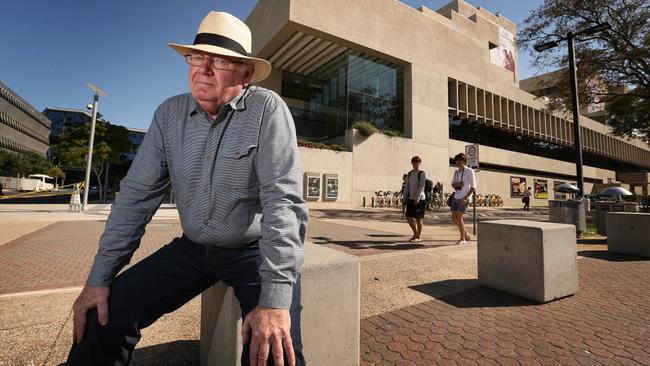Battle for arts and minds
THE visionary who shaped the cityscape will be turning in his grave, say friends.

NO one was more surprised than Allan Kirkwood when the draft master plan to revamp Brisbane’s South Bank cultural precinct emerged, seemingly out of the thin air that was to help fund it.
The veteran architect’s first thought was for his late friend and business associate Robin Gibson, credited with helping shape the Queensland capital’s cityscape. “I think Robin would turn over in his grave if he knew that this was happening in the last six months of his life,’’ Kirkwood says.
To Gibson, a grand figure in Australian architecture, the quartet of functional concrete buildings that underpin possibly the best arts complex in the country was his “essay in baroque space’’, a legacy he defended to the end.
But from the day the Queensland Arts Gallery opened in 1982, winning the peak Sir Zelman Cowen Award for Architecture, followed by the Queensland Performing Arts Centre, new homes for the Queensland Museum and State Library, there was muttering the stark, mud-coloured edifices were out of place on South Bank.
There were complaints about public entrances — or lack of them — and the absence of views of the river and CBD from the main foyers in QPAC. One critic likened the brutalist Gibson buildings to upturned ice cream containers. For all that, they retain an imposing presence, as Gibson did in public life until his death on March 28 from mesothelioma.
The draft plan for the monster makeover is dated April 2, two days before his memorial service. It’s not the first big change proposed for the cultural precinct, but the scope and scale of the redevelopment dwarfs the work previously done there, tiptoeing around Gibson’s copyright on the original buildings.
The draft master plan provides for two glassed towers, a new 1500-seat theatre at QPAC, terraced and forecourt performance areas to seat 16,000, as well as a five-storey science centre. In all, there are “over 100 modifications to the fabric and spaces’’ of the site.
Part of the cost was to be recouped by the sale of “air space’’, The Courier-Mail reported on May 6. In a media release, Premier Campbell Newman said: “The master plan is a bold vision to guide future development and investment over the 20 years.’’ What Kirkwood would like to know — and what the Queensland government won’t say — is why neither he nor his ailing colleague were consulted before the glossy 72-page document was released, so soon after Gibson’s death.
This was no mere nicety. Gibson’s moral rights over the buildings were recognised at law. A form of copyright that endures for 70 years beyond the physical life of the author, it gives the original architects a seat at the table if one of their structures is to be substantially altered.
Kirkwood had missed the news item in the local paper and did not twig to the release of the draft master plan until a friend mentioned it a fortnight ago. At that time, public submissions were due to close yesterday, before the deadline was extended to June 27.
Kirkwood’s own moral rights over the QPAC design — which he describes as his “baby’’, having been the project architect from the concept stage to completion in Gibson’s practice — has belatedly been recognised by the Queensland government. If he wants it, he will get his say on the draft master plan.
This remains a grey area of law. While views and wishes of the architect must be taken into account, the owner is perfectly free to disregard them. Moral rights do not amount to a prospective veto; they are “toothless’’, according to Gibson’s widow, Jane.
But they can be hugely troublesome if mismanaged; as the decade-long saga over redevelopment of the National Gallery of Australia proved. Another big-name architect, Colin Madigan, fought for years against changes to the entry and facade of the building, also designed in brutalist style (from the French beton brut, for raw concrete). Former gallery director Betty Churcher famously declared: “The dead hand of an architect cannot stay clamped on a building forever.’’ The case went to court, but not to judgment. The new addition opened in 2010 to generally positive reviews.
The dispute in Canberra overlapped Gibson’s fight with the Beattie government over what turned out to be a much-admired extension of the State Library. Gibson hated it.
He was also unimpressed by the siting of the $107 million Gallery of Modern Art, in an area he had envisaged for the Queensland Conservatorium of Music and the state ABC headquarters (both on the opposite side of the precinct).
To cap it off, there was talk of QPAC being “reoriented’’ to the river in a plan being developed by Brisbane architect Michael Rayner, lead author of the recently released effort.
In 2004, a fuming Gibson threatened to invoke his moral rights, saying he wouldn’t stand by while his signature work was dismantled bit by bit.
“It’s another vision, isn’t it,’’ he told this reporter at the height of the row. “It’s the same as someone grabbing Rembrandt’s brush and saying, ‘You’ve got it all wrong mate … We need a few slashes across here, lines there. But don’t worry, it’s still a Rembrandt.’ Like hell it is.’’
Jane Gibson insists her husband wasn’t being obstructive. “To be honest, this has gone on for so many years,’’ she says, sighing. “Robin was always willing to collaborate with any changes made … like the new entrances. He worked with them. It was the manner in which these changes were made.’’
Their last dealings together with the state authorities over QPAC were particularly galling to Kirkwood, 74.
In October, as he struggled with his illness, Gibson, 83, was contacted about a plan to bolt a wooden deck to the eastern end of the centre, opening off the Playhouse, one of four theatres.
After talking it over with Kirkwood, he wrote to QPAC chief executive John Kotzas noting concern about “several major design questions’’. In the letter, dated October 18, Gibson described Kirkwood as co-author of the project and said he would need to be professionally retained.
Kotzas replied on December 2, saying the deck had been dropped. But here’s the thing. No mention was made of the draft master plan. “They may have … not wanted to worry him about it,’’ Jane Gibson says. “But I thought it odd they would seek him to sign off on this very minor addition when you compare it to what was really going to happen.’’
Kotzas declined to be interviewed, but a spokeswoman acknowledged he had been aware of the draft master plan when corresponding with Gibson. “QPAC’s role was simply a participant in the consultation process, not managing consultation,’’ she insisted.
Queensland Arts Minister Ian Walker said in reply to written questions: “Unfortunately, Mr Gibson became ill and passed away while the master plan was being developed.’’
Kirkwood, a life fellow of the Australian Institute of Architects, is relieved the government has extended public consultation on the draft master plan. The debate is sure to be sharp.
Peter Skinner, a professor of architecture at the University of Queensland and former state president of the institute, says brutalism is not to everyone’s taste, including his, though he appreciates aspects of the 1970s and 80s school of design.
“It’s not quite as beastly as it sounds.” Gibson’s buildings were consistent in character and organised strongly, helping offset their “unlovely’’ exteriors.
Skinner believes it’s time to revisit how they relate to an urban landscape that has changed astonishingly from when South Bank was developed. But he doesn’t buy the trade-off at the heart of the draft master plan, the twin high-rises for hotel and commercial space. “I think it is driven … by some funding devices and I’m not convinced by that approach.’’
Having followed her father into architecture, Tina Gibson says there is no question of “letting the buildings atrophy’’.
Brisbane’s cultural precinct needed to grow and develop, just as the city had. It’s a matter of perspective, she explains from her home in Luxembourg.
“What my father has created is a unique place, a cultural quarter conceived with one vision. There are few examples worldwide of a forward-looking modern assembly of buildings that are not bombastic or to do with commercialism or power.
While the era of the buildings may not currently be fashionable, nevertheless, as an assembly of buildings it is a rare thing and hugely well respected.’’



